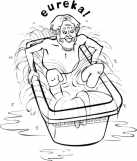Famous Scientists
Archimedes

Archimedes was an incredible mathematician, but he is mostly remembered for his mechanical genius and his discovery of a method to measure density. That method is known as Archimedes' Principle. Archemedes noticed that when he got in the bath tub the water level rose up. From this, he knew that he could discover the volume of complex shapes by measuring how much water was displaced when an object was submerged. Legend has it that he was so excited when he made this discovery that he got out of the bath tub and ran down the street naked yelling "eureka, eureka" which means "I have found it, I have found it".
Galileo Galilei

Galileo is best remembered for his dialog (book) which gave credit to the concept of the planets orbiting the sun. He is especially remember for this because: the condemnation of him, and the book (by the Church) made the rest of the world curious as to what the fuss was all about. Galileo was not the first to realize heliocentrism but his improvements to the telescope made it more obvious than it was in the past. For instance, he could see that the shadow side of Venus always faced away from the Sun. Galileo was also an accomplished musician (Lutenist, like his father) and taught art. Probably his most valuable contributions were to Kinematics and Strength of Materials for which Einstein gave him the title of "father of modern physics". (It should be noted that many have been given this title over the years.)
Isaac Newton

As a boy, Isaac Newton's interest in science could be seen from his attraction to a book called "The Mysteries of Nature and Art" by John Bate. Today he is remembered for his development of the Laws of Motion and Universal Gravitation; his contribution(s) to the development of infinitesimal calculus"; and (among other things) discoveries on the nature of light. In Newton's time, it was understood that the planets moved around the Sun. But what wasn't understood was the forces or mechanism(s) that held them in their paths. Newton also pondered this problem and put forth a thought experiment to explain what was happening. In this thought experiment, he imagined a cannon fixed on top of the world. He reasoned that if a cannon ball was shot out fast enough, the ball would just keep going out into outer space and keep on going. On the other hand, if it were shot with it normal speed, the ball would just fall to the ground (like normal). Newton reasoned that there must be an in-between speed such that the ball would be trapped in orbit. From this Newton put forth his concept of Universal Gravitation and his Laws of Motion. It should also be pointed out that the rigorousness that he displayed in his work, could be considered somekind of a scientific break through all by its self. Newton's experiments with light gave him another break through. In his time it was already known that when light passed through a prism it was seperated into colors. However, what wasn't known at that time was the nature of that sepetation. Common knowledge was that the prisim contaminated the pure white light which created the colors. What Newton did was to run the light through two prisims. But before the light made it to the second prism, he blocked all but one color from hitting the second prism. So, lets say that all colors were blocked but red so that only red reached the second prism. Newton showed that when only red went into the sceond prism, only red came out of the second prism. In this way he showed that white light was seperated into colors by the prism, not contaminated by the prism. This also brought him to the understanding as to why the telescopes of his time (lens telescopes) were incapable of magnifcation above a certiant power. This is what led him to invent the reflecting telescope since there are no lenses (in the reflecting telescope) to distort the light.
